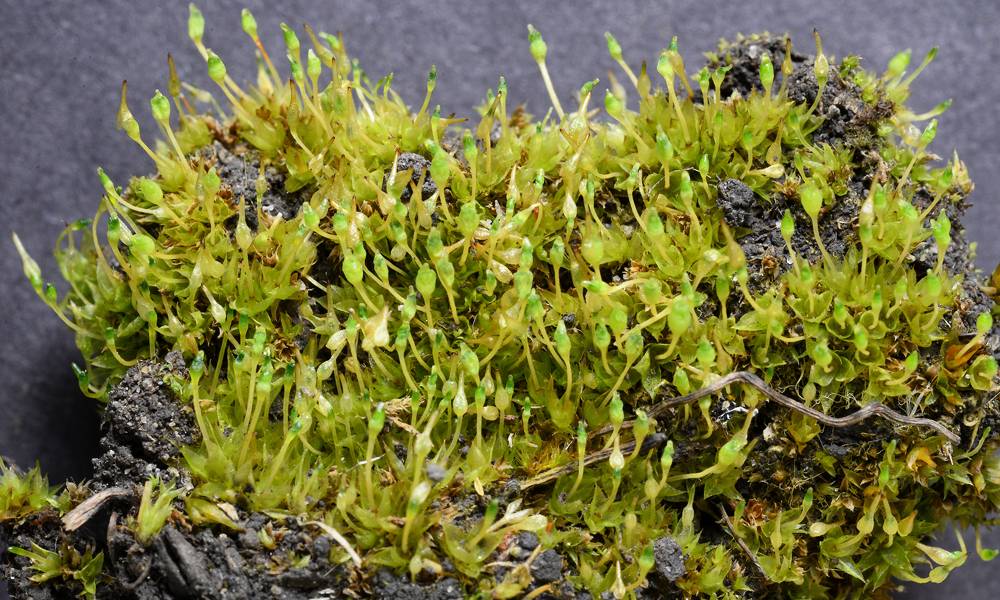
Consortium of Bryophyte Herbaria
- building a Consortium of Bryophytes and Lichens as keystones of cryptobiotic communities -
|
Family: Funariaceae |
Plants: very small, scattered or gregarious. Stems: to 5 mm, erect, branches simple or branching. Leaves: crispate to contorted when dry, erect-spreading when moist, oblong-lanceolate, 2–2.5 mm; margins serrulate distally; apices short-acuminate; costa single, percurrent; proximal laminal cells rectangular, distal cells rectangular to almost quadrate. Sexual: condition autoicous. Seta: erect, to 0.2 mm. Capsule: stegocarpous, erect, immersed, symmetric, globose, to 0.7 mm, smooth; exothecial cells collenchymatous, particularly those adjacent to line of dehiscence; stomata at the very base of the capsule, superficial; annulus narrow, consisting of 1(–2) rows of delicate, small cells; operculum conical, short-apiculate, line of dehiscence equatorial, peristome absent. Calyptra: mitrate, 4–6 lobed, small, smooth. Spores: spherical, spiny-papillose. e North America. Species 1. Plants: small, scattered to gregarious. Stems: 3–3.5 mm, erect, simple or forked. Leaves: somewhat crisped when dry, erect-spreading when moist, lanceolate, ovate-lanceolate, or obovate, plane to weakly concave, 2–2.5 mm; margins entire to serrulate distally; apices acuminate; costa single, extending 1/2–2/3 of the leaf length, occasionally slightly forked at apex, or percurrent; proximal laminal cells rectangular, distal cells short-rectangular to rhombic with narrow ends. Sexual: condition paroicous. Seta: erect, to 0.2 mm. Capsule: cleistocarpous, erect, immersed, symmetric, globose and apiculate, to 0.8 mm, wrinkled upon aging; exothecial cells irregular in shape, usually thin-walled; stomata with single guard cell, restricted to base of capsule, superficial; annulus none; operculum not differentiated, dehiscence irregular; peristome absent. Calyptra: conic-mitrate, not or slightly lobed, small, covering apiculus of capsule only, smooth. Spores: spherical to slightly elliptical, densely papillose to slightly spinulose. North America, c, n Europe, Asia (China, Japan, w Siberia), Africa, Australia. Species 2 (2 in the flora). Physcomitrella is distinguished from other Funariaceae by the immersed capsule with irregular dehiscence, and the thin-walled, translucent exothecial cells. The generic name implies a resemblance to Physcomitrium, which is named, however, for its large calyptra, unlike that of Physcomitrella. Plants: small, scattered to gregarious. Stems: 2–10(–25) mm, erect, simple or forked. Leaves: crispate to contorted when dry, erect to spreading when moist, ovate-lanceolate, ovate, to obovate, sometimes concave and cucullate, 1.2–5 mm; margins entire to serrulate distally; apices somewhat blunt, or acute to acuminate; costa single, subpercurrent to short-excurrent; proximal laminal cells elongate-rectangular to rectangular, distal cells rectangular to hexagonal. Sexual: condition autoicous, occasionally polygamous; perigonia at apices of short basal or lateral branches, usually with clavate paraphyses; perichaetia at stem apex, with a few filiform paraphyses. Seta: erect, 0.5–13(–30) mm. Capsule: stegocarpous, erect, immersed to exserted, symmetric, ovoid, globose, pyriform, or campanulate, often urceolate when dry, mouth sometimes flaring, 0.8–3 mm, smooth, neck usually wrinkled when dry; exothecial cells irregularly isodiametric, hexagonal, or oblong, sometimes collenchymatous; a few stomates usually present in neck, superficial; annulus narrow, consisting of 1–2 rows of small cells or revoluble as fragments of large cells; operculum convex to conic, apiculate to rostrate; peristome absent. Calyptra: mitrate, deeply split into (2–)3(–4) spreading lobes, long-rostrate, sometimes inflated at the base, usually large, smooth. Spores: spherical to subreniform, papillose to spinulose. Temperate North America, Mexico, Central America, South America, Europe, Asia, Africa, Australia. Physcomitrium is characterized by erect, symmetrical, and often urn-like capsules that lack peristomes. Infra-species variation of both the sporophyte and gametophyte of Physcomitrium pyriforme has led to many species being described over time in North America. Species ca. 80 (4 in the flora). Physcomitrium commonly occurs on exposed soil often associated with spring-wet sites, often on alluvial mud and river banks, from near sea level to ca. 2500 m, and the capsules mature over winter into spring. |
Powered by Symbiota.





